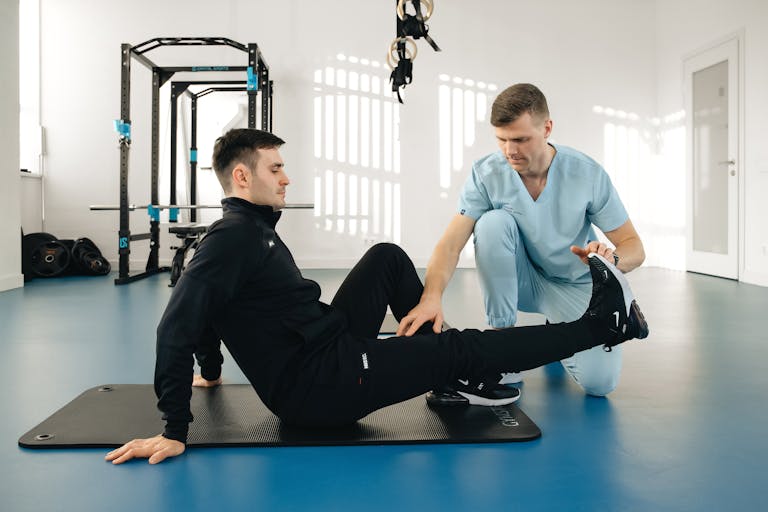9 Reasons Physiotherapy Is Essential for Gym-Goers Recovering from Injury
What Happens When Gym-Goers Get Injured?
Regular gym activity is often seen as a pathway to improved health, but intense physical exertion can lead to strains, sprains, joint issues, and muscular injuries. Whether it’s improper form, lack of warm-up, overuse, or a sudden forceful movement, injuries at the gym are more common than many realize.
Recovering from these injuries isn’t just about rest. Without structured intervention, healing can stall, imbalances can form, and the risk of reinjury increases. This is where physiotherapy steps in as a key component of safe and effective recovery.
Why Physiotherapy Plays a Vital Role in Recovery
Physiotherapy offers targeted recovery strategies that align with how the body heals. Through movement-based assessments, manual therapy, corrective exercises, and functional training, physiotherapists help restore physical ability in a way that rest alone cannot.
Here are nine specific reasons why this practice is essential for gym-goers aiming to recover fully and return to training confidently.

Looking to recover faster and get back to doing what you love? At Physio For Performance in Langley, our expert physiotherapists use cutting-edge techniques tailored to your needs.
Don’t wait—book your appointment today and experience a personalized approach to restoring your function and mobility!
1. Accurate Injury Assessment and Diagnosis
One of the first steps after an injury is understanding its sever
ity and the structures involved. Physiotherapists are trained to assess movement patterns, muscle imbalances, joint function, and tissue damage.
This initial evaluation goes beyond surface-level symptoms. For gym-goers, knowing exactly what’s wrong and how it impacts their lifts, cardio, or mobility allows for informed adjustments to their routine and recovery process.
2. Customized Rehabilitation Programs
Each injury is different, and so is every person’s body. Physiotherapy offers rehabilitation plans based on individual strength, flexibility, biomechanics, and gym goals.
Rather than generic rest periods, clients receive guidance that includes progressive exercises tailored to their current capacity. These may evolve over time, matching the body’s healing speed and restoring lost function while avoiding aggravation.
3. Reduced Downtime and Faster Recovery
Properly guided physiotherapy can help decrease inflammation, restore range of motion, and improve circulation—all of which contribute to faster tissue healing.
Gym enthusiasts are often eager to return to training. A physiotherapy-guided approach helps them resume physical activity safely by emphasizing tissue readiness and load tolerance rather than rushing the process.
4. Improved Movement Mechanics
Many gym injuries stem from poor movement habits that have developed over time—such as improper squatting depth, shoulder misalignment during presses, or core instability during deadlifts.
Physiotherapy includes movement re-education and neuromuscular training. These strategies help gym-goers become more aware of how their body moves, allowing them to build better mechanics and prevent recurring issues.
5. Pain Reduction Without Relying on Passive Solutions
Muscle and joint pain after injury can limit even daily tasks, let alone gym workouts. While rest and medications can temporarily dull discomfort, physiotherapy focuses on active pain management.
Techniques such as soft tissue mobilization, stretching, dry needling, or specific strengthening protocols work directly on the affected area, reducing pain through function rather than avoidance.
6. Reintegration Into Physical Training
One of the unique values of physiotherapy for gym-goers is its bridge between rest and performance. Instead of simply waiting for pain to go away, clients are gradually reintroduced to gym activity using controlled load progression.
This could involve modified lifts, guided resistance exercises, or cardiovascular routines that restore both strength and confidence without overstressing healing tissues.
7. Prevention of Secondary Injuries
After an initial injury, the body may compensate by overusing other muscles or joints. This often leads to additional strain in unrelated areas such as the opposite limb or the lower back.
Physiotherapy includes strategies to address the root cause of dysfunction and prevent cascading effects. For gym users, this means protecting future performance by rebuilding total-body stability and alignment.
8. Psychological Support During Recovery
Physical injuries can be mentally challenging especially for people who use the gym as a stress outlet or personal discipline practice. Anxiety about reinjury, loss of progress, or reduced ability is common.
Working with a physiotherapist provides structure, feedback, and reassurance. Setting small milestones during recovery fosters a sense of achievement and progress, which helps maintain motivation and a positive outlook.
9. Long-Term Physical Maintenance and Performance Enhancement
Physiotherapy isn’t only for immediate recovery. Many gym-goers benefit from ongoing guidance to improve mobility, strengthen weak areas, and optimize their body for higher performance.
By identifying recurring tension, mobility restrictions, or control deficits, physiotherapy allows individuals to train smarter, reduce chronic stress, and maintain overall joint health well beyond the recovery period.
How Physiotherapy Complements Gym Training
For many, the gym is a place to build strength, endurance, and discipline. But training without body awareness, recovery knowledge, or injury prevention strategies can lead to setbacks. Physiotherapy complements fitness by reinforcing the foundation on which strength is built.
Whether someone is recovering from a shoulder strain, ankle sprain, or lower back pain, this approach ensures that they don’t just heal they come back more balanced, controlled, and efficient.
When to See a Physiotherapist After a Gym Injury
Many people wait too long before seeking help. Common signs that it’s time to consult a physiotherapist include:
- Pain that persists more than a few days
- Loss of range of motion
- Inability to load or use a joint normally
- Repeated injuries during workouts
- Difficulty regaining previous strength levels
Early intervention can prevent minor issues from becoming long-term limitations.
Building Resilience Through Recovery
In the world of fitness, injury is not uncommon but with the right support, recovery can be a gateway to improved physical awareness and strength.
Physiotherapy serves as both a recovery tool and a performance enhancer. For gym-goers, it ensures the path back to training is structured, informed, and aligned with long-term wellness.
If you’re navigating recovery and looking to return to the gym with better mechanics and confidence, the team at Physio for Performance offers the guidance and support needed to help you move forward with purpose.







